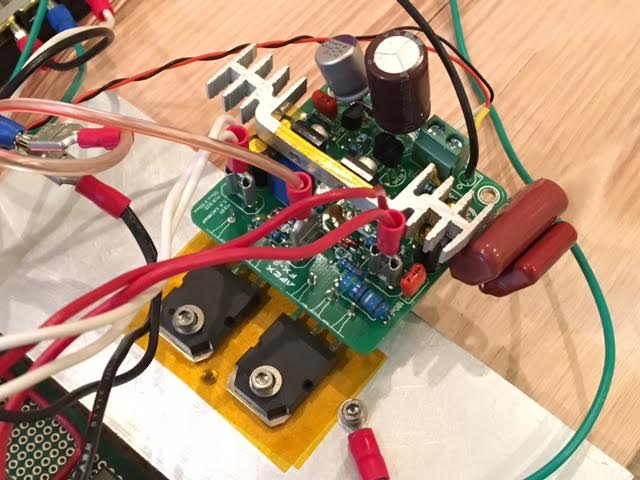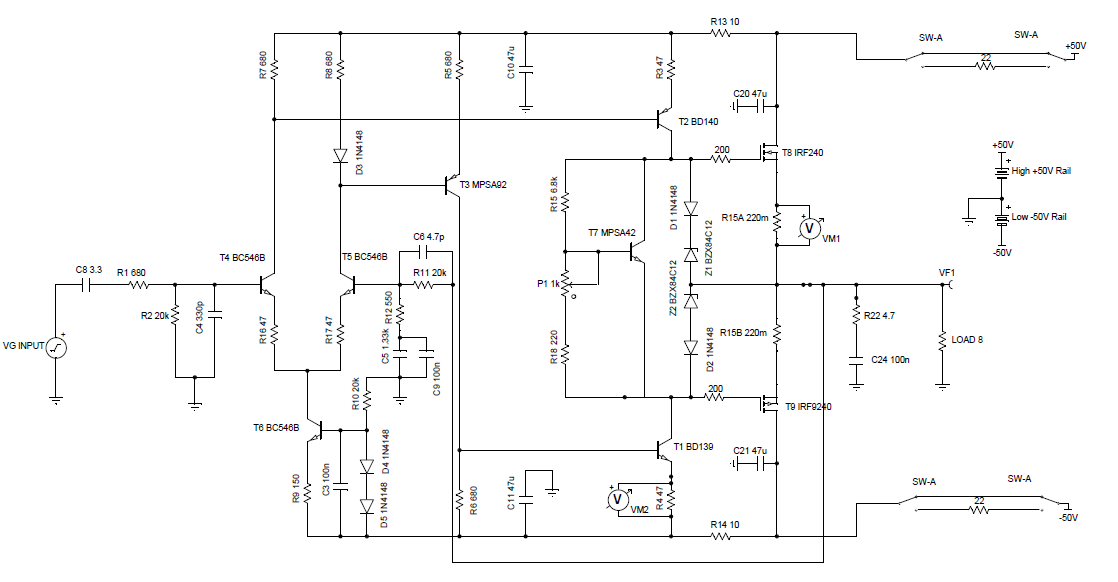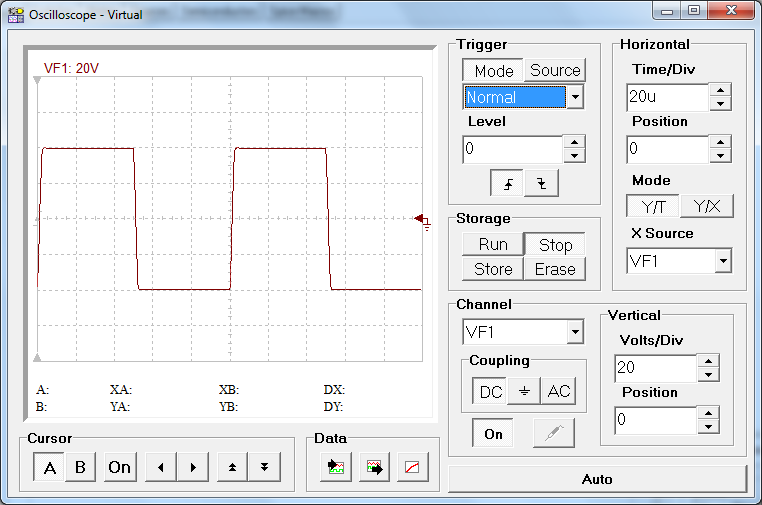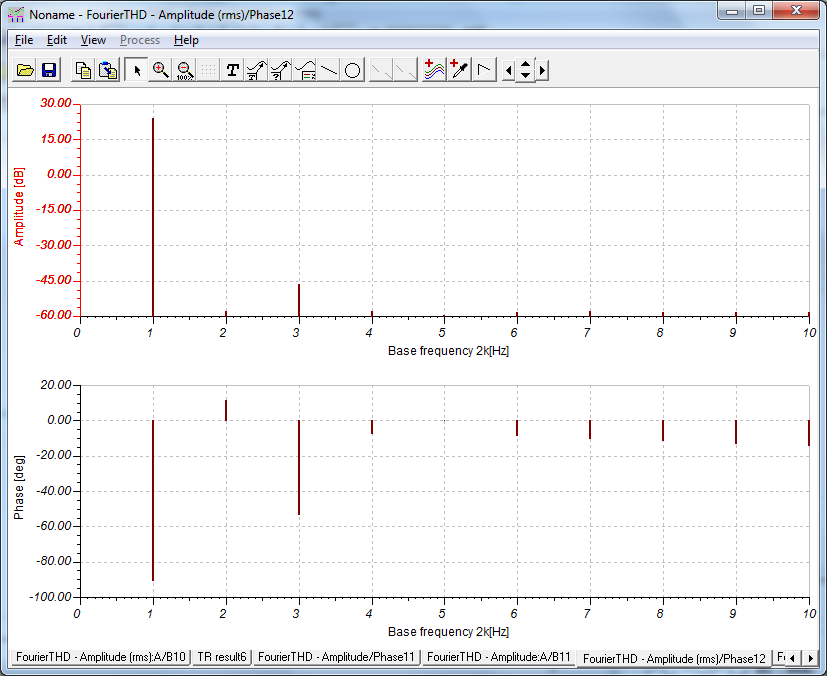I don't get the deal with these tpa3118 sanwu boards. Quite unimpressive compared to my 41Hz amp 6 TA2020. Didn't use the same power supply so I I'll try that, but doubtful. The powersupply im using for amp6 is a cheap and nasty smps.
Any cheap amps that are better than the amp6 TA2020?
Any cheap amps that are better than the amp6 TA2020?
The 100W was maximum peak output I assume ? Already close to 50W now ?
PCB male soldering tabs
Online Shop 80pcs Board Mount PCB Solder Tab Male Terminals Uninsulated 6.3mm x 0.8mm|Aliexpress Mobile
There are two sizes 4.8mm and 6.3mm wide. I like the wider ones.
Here is the latest incarnation of that little MOSFET amp.

With a 35v rail supply I am able to only get 50w into 8ohms. I just finished a simulation of this amp modified for hexFETs and a 50v rail. That should do 100w with 8ohms. Have not built it yet though.

Here is predicted performance with 10khz square waves at 100w:

With 65w sine wave the distortion components are predicted to be:

Sorry for the OT as this is class AB. However - I would recommend anyone playing with class D and wanting the urge to get more bass and dynamics to try a simple class AB discrete transistor amp. They are quite easy to build and fun. Just get yourself a dual rail toroidal PS and you are set to experiment.

Here is predicted performance with 10khz square waves at 100w:

With 65w sine wave the distortion components are predicted to be:

Sorry for the OT as this is class AB. However - I would recommend anyone playing with class D and wanting the urge to get more bass and dynamics to try a simple class AB discrete transistor amp. They are quite easy to build and fun. Just get yourself a dual rail toroidal PS and you are set to experiment.
Last edited:
Just received my 3118 boards along with a 3110.
Anyone recognizes what brand electrolytic caps are used?
Sanwu TPA3118 is small... but Sanwu TPA3110 is even smaller!
View attachment 540522
TPA3110 is for a X-wing subwoofer. Rebel music...
May the TPAforce be with us!😀
View attachment 540524
How is that working out for you?
I just got two of those sanwu TPA3110,
they produce sound but not ampification, in the same way.
I note that R3 and R4 are missing, I'm not expected to solder on some gain setting resistors am I?
@xrk971: You are not telling that we need to go back to class AB are you ? 😉 That class D is not worth the hassle .....
Just bought a FX Audio D802 (avoid the 802C with garbage emitting bluetooth inside) which is a very nice amp and way better value than TPA modules. It is encased, has only digital inputs as it is DDX and it is so cheap that it can compete with the modules with added DAC, remote control, PSU and case. With other words: after having tried many cheap modules I think there are nicer amps around with good sound quality and added useful features.
Just bought a FX Audio D802 (avoid the 802C with garbage emitting bluetooth inside) which is a very nice amp and way better value than TPA modules. It is encased, has only digital inputs as it is DDX and it is so cheap that it can compete with the modules with added DAC, remote control, PSU and case. With other words: after having tried many cheap modules I think there are nicer amps around with good sound quality and added useful features.
Last edited:
Haven't tried many ddx, just hifimediy's and a commercial big US brand name, and do not see those being superior in anyway, the opposite actually, inferior in almost every way. That is on normal speakers, can't even try them on difficult low impedance speakers, they struggle enough with 4 ohm.
How is that working out for you?
I just got two of those sanwu TPA3110,
they produce sound but not ampification, in the same way.
I note that R3 and R4 are missing, I'm not expected to solder on some gain setting resistors am I?
Chippin 5 and 6 are for gain, see if they are connected to any component or just gnd.
Haven't tried many ddx, just hifimediy's and a commercial big US brand name, and do not see those being superior in anyway, the opposite actually, inferior in almost every way. That is on normal speakers, can't even try them on difficult low impedance speakers, they struggle enough with 4 ohm.
"They" is then just too much generalizing. Which US brand name did you try ? I discount the hifimediy as it is yet another cheap DIY/ kit device.
The ones I have tried or which i have in my possession, have no problems with difficult loudspeakers. I fail to see why DDX amps in general would have difficulty driving difficult loudspeakers. They gather quite a following (but so do the TPA boards). They are interesting enough for me to try them out anyway. The technology itself is on paper quite advantegeous. In practice most of them sound uncolored which might not appeal to everyone. The signal path is short, a DAC is not necessary anymore and most chip manufacturers will switch to DXX anytime soon as it is the technology that will be cheaper to make and we all know where that leads to. Also no need for quality potentiometers and switches.... It is hard not to see we have a winner here, even if it might not be the answer to audiophile demands (also counts for class D really).
Last edited:
Álso the Hifimediy is more expensive than FX Audio D802, even without chassis.
XRK has active speakers that have the same digital ddx chipset as FXaudio, in hifi amp they use like 30 voltage regulators everywhere and add analog by wolfson/cirrus adc.
Your difficult speakers might be 8 ohm.
XRK has active speakers that have the same digital ddx chipset as FXaudio, in hifi amp they use like 30 voltage regulators everywhere and add analog by wolfson/cirrus adc.
Your difficult speakers might be 8 ohm.
They're 6 Ohm according the shield and they're 2.5 Ohm at certain frequencies.
Irribeo, please catch up on DDX ! 😉
Irribeo, please catch up on DDX ! 😉
They struggle with 4 ohm. They manage on a 4 ohm MarkAudio speaker without zobel. Do try and tell me if you own classAB amplifiers that run as hot as these ddx's heatsinks get trying to play loud on 4 ohm "constant" load. I don't have a class AB that produces that much heat, not even the notoriously badly cooled british vintage amps.
@xrk971: You are not telling that we need to go back to class AB are you ? That class D is not worth the hassle .....
JP,
No, not saying class D is not worth the hassle at all. If anything it is way less hassle than class AB which requires a big dual rail supply. However, it is not cost and compact size that class AB loses out on as I have seen with my own eyes how compact a powerful discrete transistor class AB amp can be. They sound very good and will blow the socks of my class D TPA's in the bass dynamics department. They are not to shabby in the HF range either when designed and implemented well. There is something very pure and tangible with seeing that the power supply input goes to the collector pin 15mm away and the speaker output is connected to the emitter pin 15mm away with big fat spade terminals. That transistor is like a big flow valve all in analog no PWM pulses and filtering post-facto. Just a simpler more pure approach to getting sound. Coming from years of class D where an inductor and a bunch of caps are standard fare - it's a nice change.
Thanks for pointing out DDX! Just looked at it and see that it has positive and negative PWM drive states. Interesting. I assume it requires dual rail supplies then?
http://www.temposemi.com/wp-content/uploads/docs/Tempo_DDX_APN_20131231.pdf
Last edited:
If only Hypex understood no feedback was the future 😀
You should talk to Bruno directly😉 and may be tell him how to design Class D amps
Thanks for pointing out DDX! Just looked at it and see that it has positive and negative PWM drive states. Interesting. I assume it requires dual rail supplies then?
Good question ! Some of the ones I have do have dual supplies but I am certain one of them hasn't. Anyway I think it is the future as analog sources will dry up. Almost every new device is digital anyway 😉 The link you pointed to gives a good explanation of the reduced RF/EMI at the outputs of DDX amps.
As said before, I can recommend FX Audio D802 (without the "C" !) if you just want to try out without spending too much. Beware: you will possibly end up with an almost empty audio rack !!!!! Do not underestimate this risk and see your physician if it leads to feelings of emptiness. Try to compensate by selling all (now redundant) expensive coupling capacitors, selector switches and attenuators with gold plated contacts of your vast stock.
Last edited:
Well 'funny' Bruno doesn't agree:
https://www.audioholics.com/audio-amplifier/the-truth-about-digital-class-d-amplifiers
https://www.audioholics.com/audio-amplifier/the-truth-about-digital-class-d-amplifiers
Well 'funny' Bruno doesn't agree:
https://www.audioholics.com/audio-amplifier/the-truth-about-digital-class-d-amplifiers
That was 2004, haven't things in class D changed substantially in SOA since then?
I agree that a good analog class AB is easier to design as anyone with a simulator and basic concepts of power amp building blocks (long tail pair (LTP) differential input stage, constant current source (CCS), current mirror, voltage amplification stage (VAS), negative feedback (NFB) stage, and output stage (OPS) can muddle their way through it and actually produce an amp that sounds good. It's posible because the simulator will tell you if it is stable, what the square wave looks like, what bias current to set, and what the HD might look like. It's actually a lot of fun because knowing nothing 3 months ago, I am simulating my own amps and putting some cool mods on existing amps. It's also a lot cheaper and quicker to get instant gratification than building a big speaker out of wood. However, a great or super class AB still requires people with some pretty specialized knowledge and tricks - the forum design Gods from Mt Olympus. There are maybe a handful...
Well 'funny' Bruno doesn't agree:
https://www.audioholics.com/audio-amplifier/the-truth-about-digital-class-d-amplifiers
2004 my friend.....then DDX was done with 74XX chips or tubes 😉
- Home
- Amplifiers
- Class D
- Cheap TPA3118D2 boards, modding them and everything that comes with it